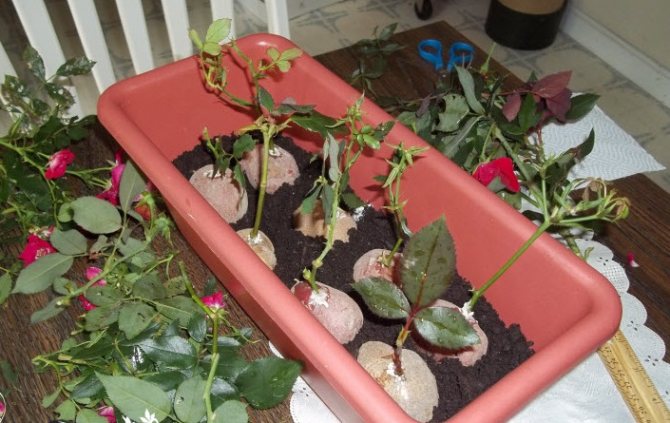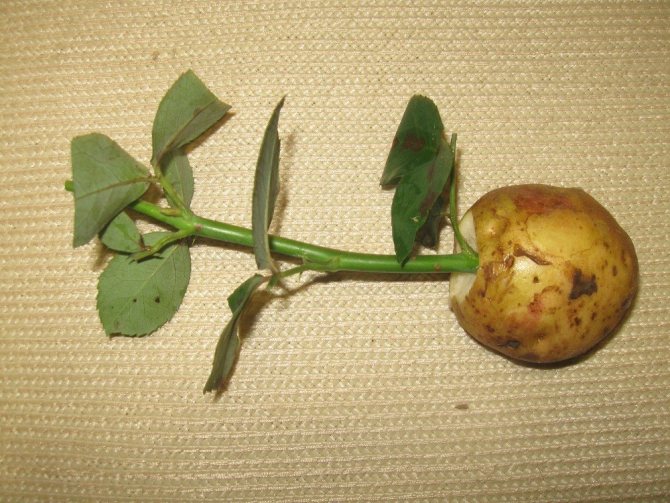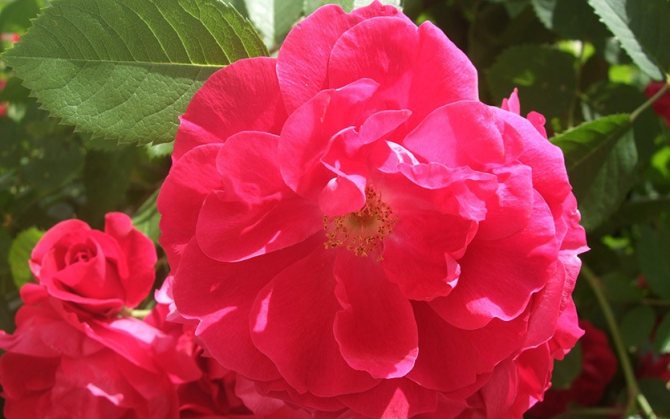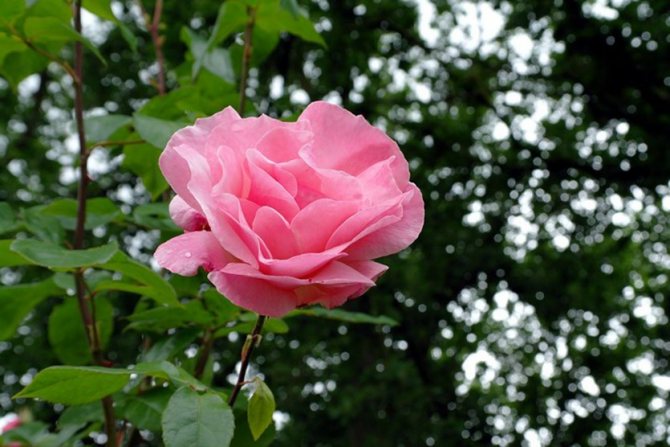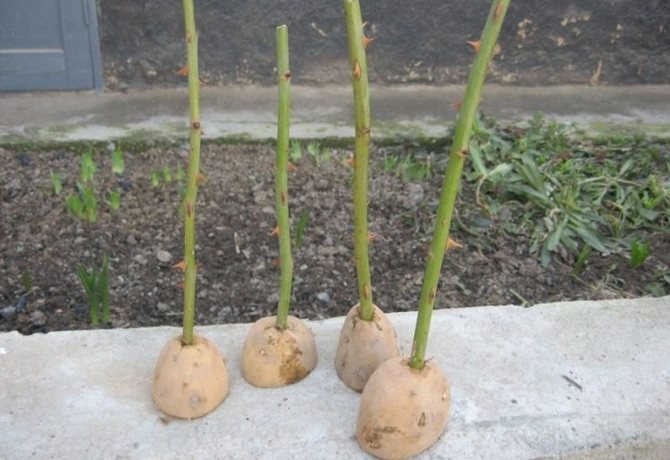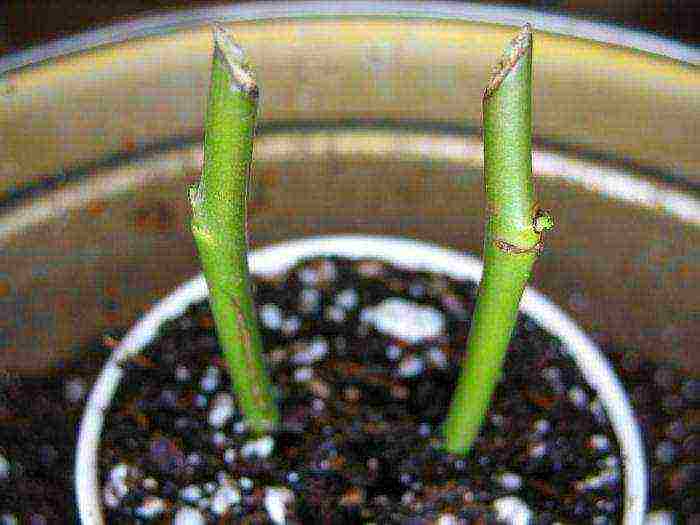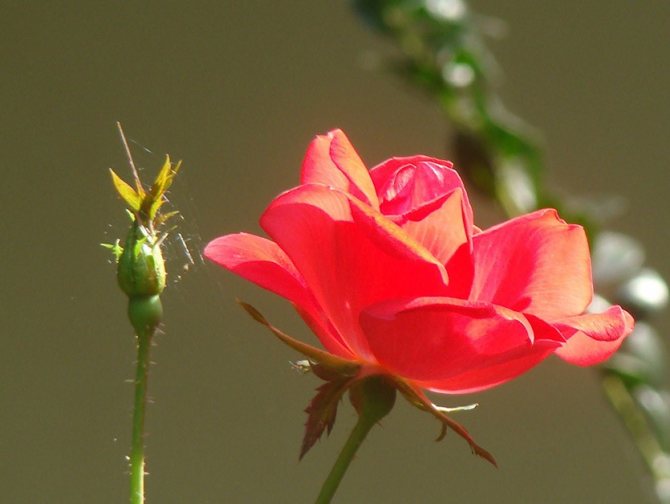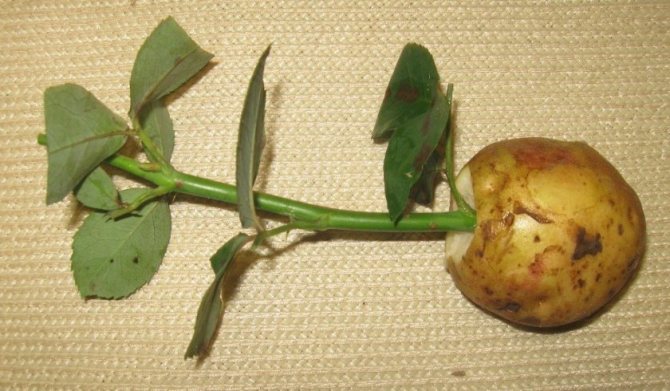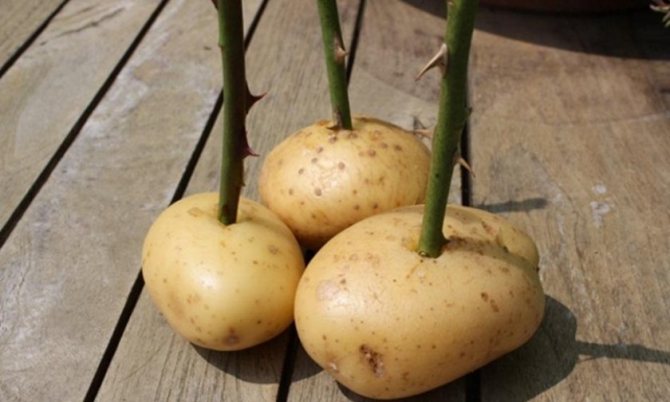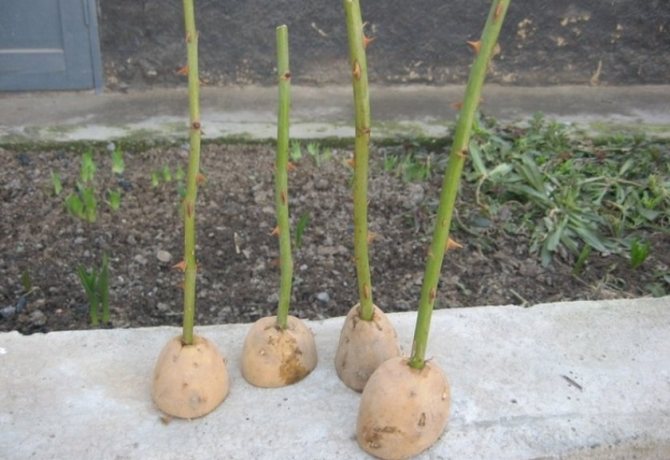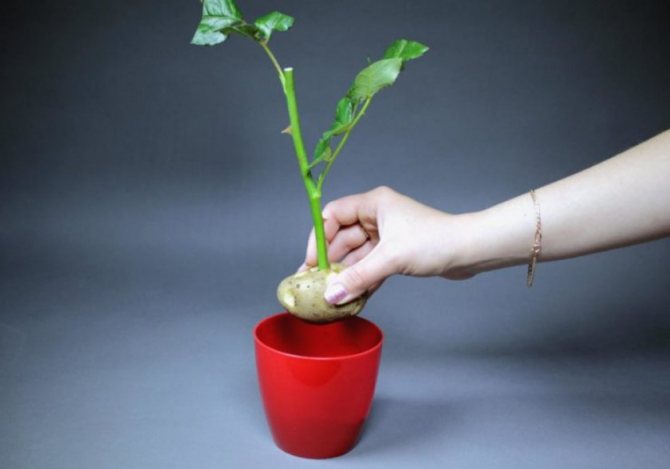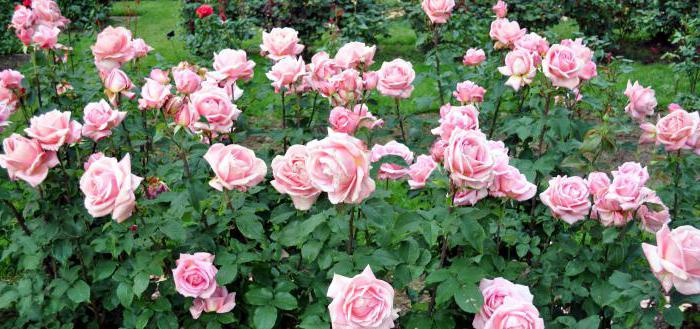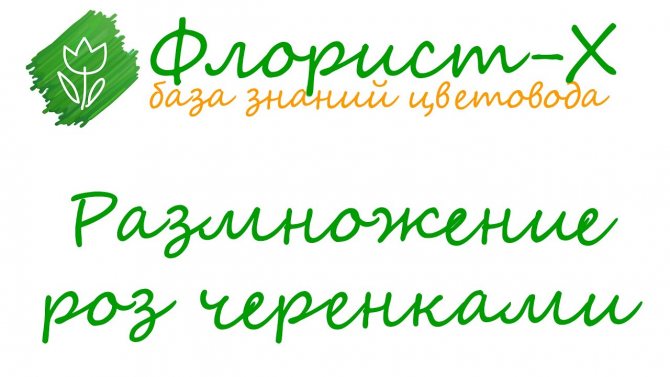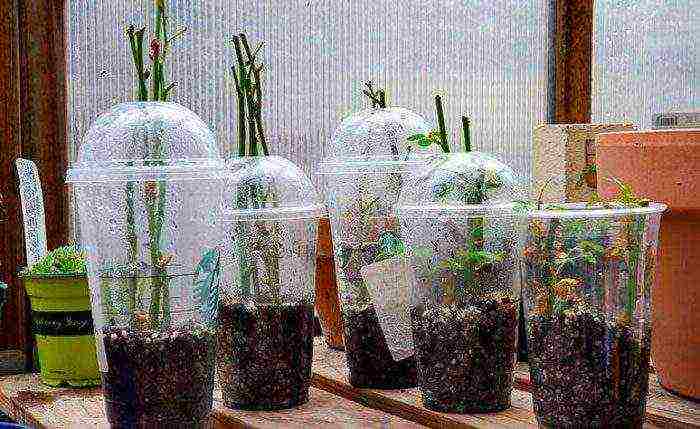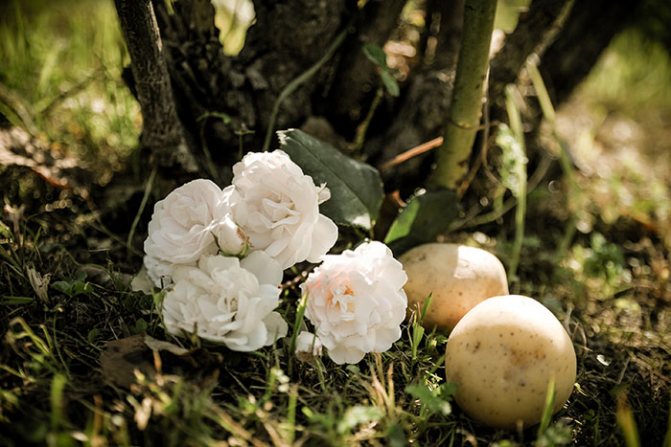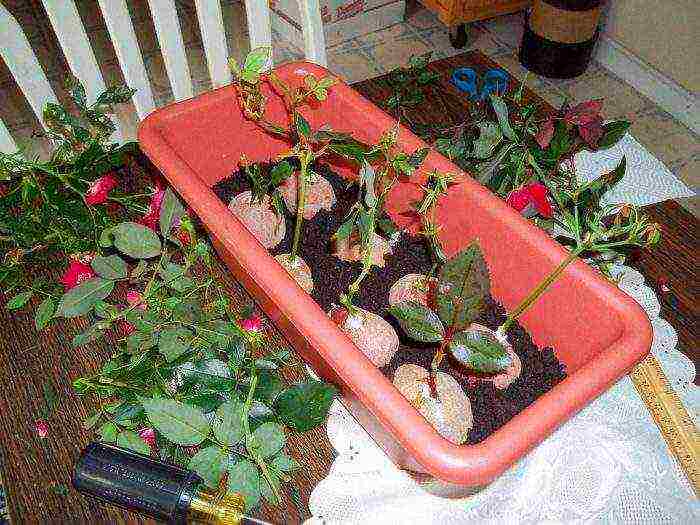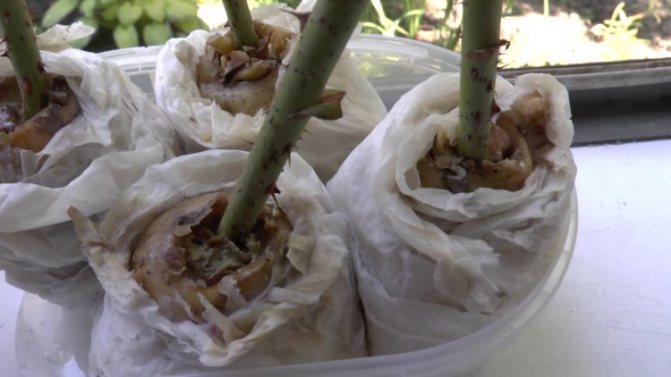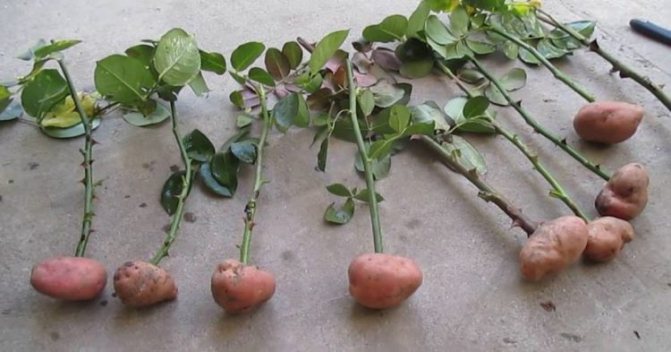Roses presented for the holiday can be used as planting material at their summer cottage. To propagate the variety you like, you will need several potato tubers and simple materials at hand. The survival rate of cuttings with this method is 30-70% and depends on many factors. However, knowing how to choose a flower for planting, how to cut it correctly, how to root a rose from a bouquet at home in a potato and how to care for plants in a tuber, even an inexperienced florist can grow bushes of his favorite flowers in his flower bed.
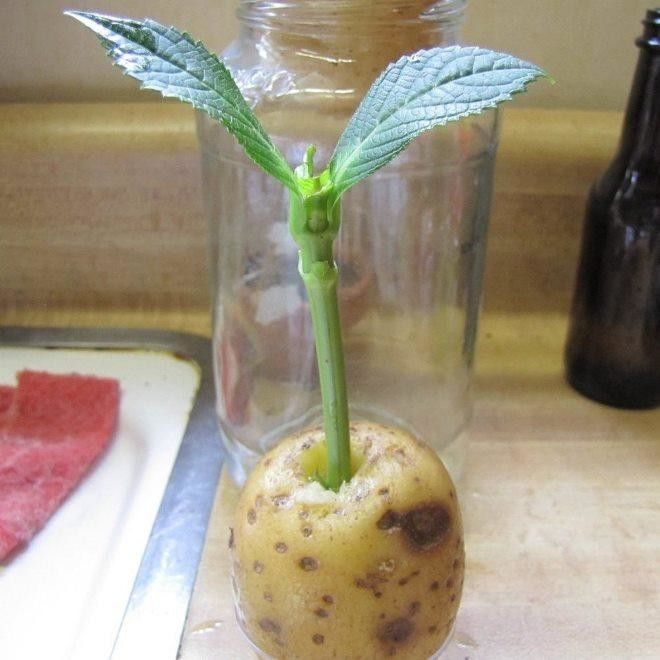
Young tubers that have recently been dug out are better suited for planting, because they contain the maximum set of substances necessary for plants.
Growing a flower in a potted pot at home
When propagating by cuttings, the following problem arises: cuttings of roses are very whimsical and often dry up when grown in soil, and when grown in water, they rot from lack of oxygen. So how do you provide both oxygen and constant humidity at the same time? It turns out that this dilemma can be solved with the help of ordinary potatoes.
Rooting rose cuttings with potatoes is a very common method among the people. and the most efficient. You will not regret using potatoes to plant a rose cut. He will feed the cutting and protect the flower from disease.
Cutting in packages
Cutting roses in the summer in July or June can be carried out in ordinary plastic bags. There are two ways.
1. Burito. Several (up to 10-15 pieces) prepared cuttings are collected in a bunch, thin layers of moss are made between them. This whole structure is carefully wrapped in newspaper so that there are no gaps left, and moistened with water. You can simply sprinkle and drain off excess moisture, or better wrap it in a wet rag for five minutes. Next, the newspaper roll (without the fabric) is wrapped in a plastic bag so that there is minimal air access. All this is placed in a cool place (+ 18 ° C is the ideal temperature regime). Lighting there should be minimal. Roots appear in 3-4 weeks. For the entire waiting period, you need to inspect the cuttings at least 1 time a week and throw away the rotten ones.
2. In moss. A plastic bag is filled with moss, moistened with a solution of aloe juice and water (1: 9), cuttings are placed there. Next, the structure must be filled with air and tied very tightly. There should be no cracks. It turns out like mini-greenhouses. Such inflated bags with cuttings are hung on a window, where direct sunlight does not fall, and they wait 3-4 weeks for root formation.
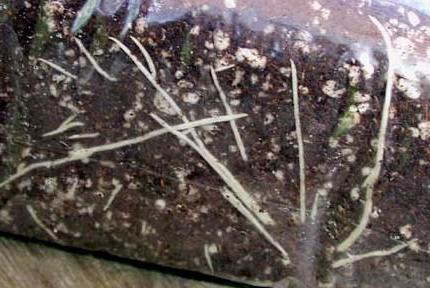

Pros and cons of this rooting method


Cutting potatoes not only create a moist environment, but also provide the nutrients necessary for growth. After all, it contains starch, proteins and mineral salts, which are so necessary for the shoot for growth and root formation. Without a root system, the stalk is not able to take these substances by itself, and the potato supplies it with everything it needs.
Also potato serves as protection against hypothermia, drying out, from various pests and pathogens... This is the undoubted advantage of this method.And the only drawback is that, despite the developed root structure, according to statistics, approximately 15% of seedlings do not take root when transplanted to a permanent place of growth (however, the same happens with other methods).
Preparing a place in the garden
This is the most optimal option, since the planting material is immediately placed in a permanent place and does not require further transplants. The second plus of the method is that the stalk is more hardened and better prepared for wintering. Cutting roses in June or July (with further planting in the ground) begins with choosing a place. The site should not be under the scorching sun, be open to all winds and constantly flooded with water. Ideal if this place is in partial shade. The soil for the cutting should consist of sand (no clay), turf and deciduous soil. The proportion is 1: 2: 2. The composition of the soil can be as follows: woody, leafy earth, sand, humus and wood ash in a ratio of 4: 1: 1: 2: 0.5. In the designated place, make a ditch (or hole) up to 15 cm deep, fill it with a prepared soil mixture, pour 2-3 cm of sand or a mixture of sand and peat (1: 1) on top, treat it with a solution of potassium permanganate.
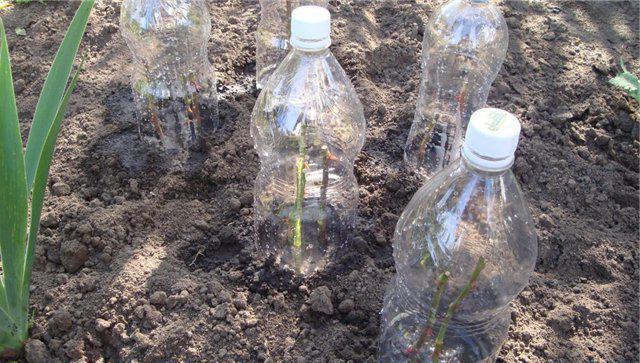

Step by step instructions: how to plant and root a flower in a potato?
To grow a rose in a potato, you should strictly adhere to the following algorithm for planting and rooting cuttings:
- Prepare your inventory. You can take medium-sized pots (at least 20 centimeters high) or even use plastic bottles. Divide the bottle into two parts: the handle can be placed in the lower half, and the upper half can be covered. We get a small greenhouse.
- Prepare a rose. When preparing the cutting, consider the following: the lower cut should be done 2 centimeters below the kidney at an angle of 45 degrees, and the upper one - 1 centimeter above the kidney at a right angle (90 degrees). The length of the cutting is 20-25 cm. It is better to cut the shoot under running water so that air does not get into the cut, with a pruner or a sharp knife.
All thorns and leaves should be removed from the cutting, as moisture is lost through the leaves. To make the cuttings germinate faster, you can put them in a biostimulant solution for a day: root, epin, heteroauxin. If for some reason there is no biostimulant, put the cuttings in a weak manganese solution for 30 minutes.
- Prepare the potatoes. Large or medium sized tubers are suitable, without damage or signs of disease. If the potatoes have eyes, remove them to avoid sprouting.
- Plant potatoes with cuttings. Burn the cuttings with a solution of potassium permanganate and stick the cuttings into the potato, up to about the middle. Lay drainage at the bottom of the pot (you can take small pebbles), and sand on top - 3-5 centimeters thick. Put a potato with a shank there, cover it with humus or soil mixture on top, any store-bought flower mixture will do.
Humus should be disinfected in advance with 2-3 frosts in the freezer for 2-3 days. From time to time, microflora reducing agents should be added to the soil - Fitosporin or Baikal M-1. - Create a greenhouse effect. To maintain warmth and humidity, a greenhouse effect should be created: if the stalk is planted in a pot, it should be covered with a jar, if in plastic, then the top of a plastic bottle. Place the pot with the plant in a place where there is a lot of light, but there is no direct sunlight.
- Waiting for the result. Now it remains to look forward to the result. How do you know if the cuttings have roots? After about 10-15 days, you need to carefully pull out the plant, if it came out easily, then it has not yet taken root. It should be reinstalled in place, and the check should be repeated after a week.
Cuttings in containers
Cutting roses in the summer at home is used in cases where a place for planting a new bush has not yet been determined, as well as in areas with severe winters.Use boxes, plastic cups, or regular plastic drinking water bottles as containers. Holes are made in the bottoms to remove excess moisture. The further process is no different from planting the cuttings in the ground. The container with the future rose is covered with plastic wrap and placed in a place where the temperature is kept within +25 degrees, but not in the sun. The cuttings also need to be sprayed regularly. That's the whole secret of how to carry out cuttings of roses in containers in the summer. The photo clearly shows how it looks. After about 3 weeks, the seedlings need to start hardening, for which the film is first removed for an hour or two, then the time is increased and, in the end, it is removed completely. Spraying during this period is also gradually reduced. To overwinter a new, still weak plant, it is better to leave it in a container, placing it in a cool room. To maintain humidity, as well as to protect against some pests, a young rose will need to be sprayed at least once every few days. You can also bury containers with rooted cuttings in the ground for the winter. To do this, make a trench, place containers there, cover them with spruce branches (so that air remains around the seedlings), on top with a film or roofing material, and then sprinkle it with earth. You need to open such containers in the spring, focusing on the weather. The protective material is removed, and the spruce branches are left for a couple of days. Then they remove it too.
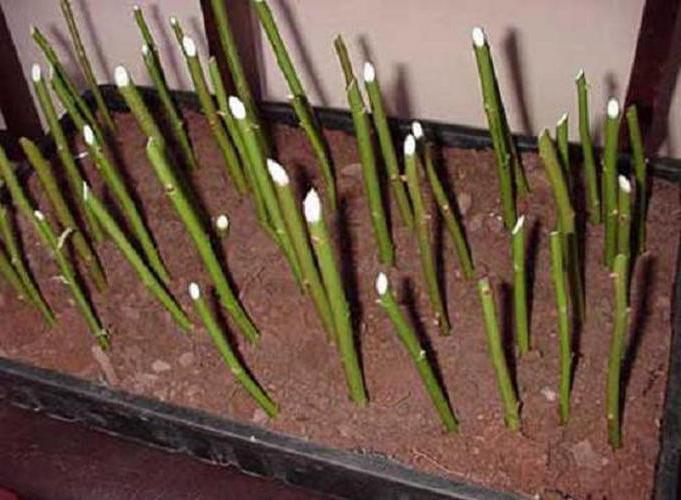

Further care


A prerequisite for rooting cuttings is to maintain constant soil moisture. Watering should be done regularly, but not very intensively. Besides watering, the cutting should be constantly sprayed with water at home temperature.To give the plant additional feeding, once a week you can water it with a sugar solution: for 0.5 liters of water - half a glass of sugar.
The stalk also needs good lighting, an abundance of sunlight will help the stalk grow into a full-fledged flower, only you need to make sure that the shoots do not overheat. After the buds appear, the shelter should be removed, first for a short time, then increasing the airing time, gradually adapting the rose to environmental conditions. After one or two weeks, the caps are removed completely. After that, the rose should be watered every day.
Care features
After the planting procedure, it is necessary to create a greenhouse effect for the seedlings for faster and more effective engraftment by covering them with plastic bottles and glass jars. At first, it is necessary to make regular almost daily watering of the planted tubers with future roses, since the soil must be sufficiently moist.
After 5 days, rose seedlings should be watered with a sugar solution (2 tablespoons of sugar per 1 glass of water). Such replenishment contributes to a more productive formation of the root system. The presence of sunlight at the root of the seedlings helps to quickly grow a full-fledged rose bush.
After the first sprouts appear, you need to start removing the protective cover made of plastic, glass or cellophane from the seedlings, gradually making them longer in the open space. So the seedlings will quickly and without problems go through the process of adaptation to environmental conditions.
Difficulties and ways to solve them
Successful cuttings of roses do not require large material costs, but certain theoretical knowledge is needed. To avoid difficulties and get excellent results, novice rose growers can use the following tips:
Well, we got acquainted with all the nuances of growing a rose from a cutting at home. To increase the likelihood of removing a rose, it is better to root several cuttings at the same time.
If you didn't succeed right away, do not despair, keep experimenting, everything will certainly work out. But we will delight the beautiful flower obtained as a result of your labors for years with its divine appearance and incomparable aroma. In addition, it will become a reliable amulet for your family nest, take away all the negative energy and give you good luck in all your endeavors.
What cuttings are suitable
Despite the fact that cutting a rose in the summer is considered a fairly simple job, it also has its own nuances. One of the main things is the right choice of cuttings. The most suitable stems are young, but already semi-lignified. Flowers on them must be loose, and well-developed buds must be present in the leaf axils. Some gardeners practice harvesting cuttings from green twigs as thick as a standard pencil, on which the buds have not yet opened, but their color is already clearly visible. They are harvested from the middle of the bush or from the very bottom. It is not recommended to use stems on which roses have already bloomed and crumbled. Completely lignified shoots are also taken for cuttings, but such material is harvested only in the fall and stored until spring. Stems for cuttings are taken only for the current year. Their thickness should not exceed 5-7 mm.
Important! Not all roses can be propagated this way. It is successful to cut a climbing rose in summer, but only varieties with small flowers, as well as polyanthus, miniature and ground cover varieties, are suitable for this. For floribunda roses, the result will be 50 x 50. Dutch varieties, as well as park and hybrid tea, are difficult to cut. It is noticed that the best result is obtained with red roses, the situation is a little worse with white roses and very difficult with pink ones.
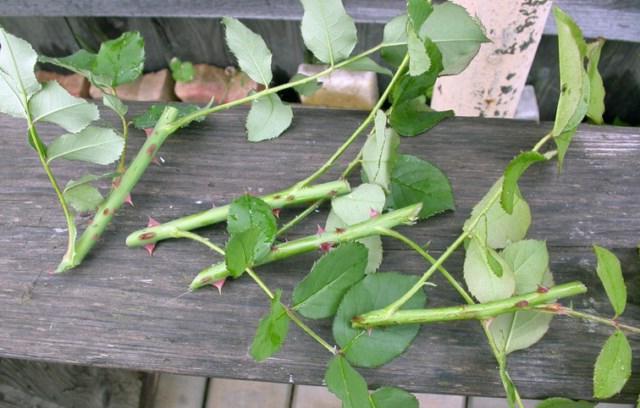

Technology of growing cuttings of roses in potatoes
Planting roses on a personal plot is the dream of, if not all, then very many gardeners. But seed material is usually expensive, and there is no guarantee that a rose of the same variety will grow from a nondescript seedling, the name of which flaunts on the label. Breeding roses with cuttings in potatoes makes it possible to grow a bush even from a presented bouquet.
In a store or in the market, grafted plants are sold, it also happens that the miracle of selection does not live up to expectations, the graft does not take root. And instead of a purebred beauty, an ordinary rosehip grows, on which the vaccine was made.
If reproduction is carried out in a vegetative way, then there will be no surprises, an exact copy of the plant that served as a "donor" of the planting material will grow from the cuttings. Such bushes are called own-rooted.
For the cultivation of roses by cuttings, it is advisable to choose domestic zoned varieties. Material from roses with white and greenish flowers is not suitable for vegetative propagation. The percentage of rooted cuttings from bushes with orange and yellow flowers is also low. Roses of red and pink varieties take root very well.
Climbing and semi-climbing, dwarf, polyanthus and bush roses are excellent for cultivation by cuttings, this is due to their genetic proximity to their ancestor - wild rose hips, which has excellent survival rate.
Imported roses are unfortunately not the best option. Before sending flowers on the road, growers treat the plants with chemicals and preservatives. Of the total number of planted stems, only 10-15% take root. But it makes sense to at least try! Procurement of planting material
Cuttings are taken both from a bush and from cut flowers from a bouquet. You were presented with luxurious roses as a gift, just the same you have always dreamed of planting in your country house? This is a good opportunity to give flowers a second life.
If it is decided to grow a bush from a cutting, it is better to take fresh flowers for this: after a long standing in a vase, the stems are depleted, the likelihood of rooting and survival decreases. Before putting the bouquet in water, the stems of roses are cut obliquely with a sharp knife under running water so that air does not get into the cut, and a biostimulator (a drop of honey) is added to the water. The water is changed daily and the cut is updated. Before grafting, the bud must be cut off.
The best time for harvesting cuttings from a bush: June - July, before flowering or immediately after it. Much depends on local weather conditions. Choose dense stems of green or brown tint (a sign of the beginning of lignification), without any defects, with a diameter of about 1 cm. If the shoot is ripe for grafting, the thorns from it should easily break off.
Several cuttings 15-20 cm long can be cut from one shoot so that each of them has three active buds. Experienced gardeners recommend making the lower cut immediately under the bud, about 2 mm lower, beveled at 45 degrees, and the upper cut at a right angle, 1-2 cm higher than the first bud.


Before kilchevaniye (preparation for rooting and activation of growth) you need:
- remove thorns;
- cut off all leaves, except for the top two, which should be shortened by 1/3;
- cover the upper cut with either paraffin or garden varnish so that there is no excess moisture evaporation.
- These manipulations are carried out so that the cuttings do not rot when they get into a humid environment.
There are several ways in which they cause the growth and development of the root system in rose cuttings before planting in a permanent place, they are placed:
- in a container with water;
- in a potato tuber;
- into a wet cloth;
- in several layers of the newspaper (burrito method);
- into the ground, instilled with an inclination of 45 degrees (Tranois method).
When can a rose be rooted?
The optimal period for cutting rose bushes is late spring - early summer, when the flowers have not yet bloomed. Then rooting will take place in the summer, when conditions are most favorable for the development of the root system of any plant. In the fall, the flower will grow as strong as possible, and the winter cold will not be so terrible for it.
Important! Not fully ripe roses are not suitable for cuttings from them. To check the maturity of the plant, you need to try to break off the thorns: in mature stems they can break off, and in green ones they will only bend. Strong stems with live leaves are suitable for reproduction.
Roses in potatoes
This method is the easiest for those who have just started planting roses. The essence of the method of reproduction of roses in potatoes is that the cuttings are not planted directly into the ground, but are first placed in the tuber, which supplies the stem with nutrients: starch, vitamins, phytohormones, moisture. Also, the potato serves as protection against hypothermia, drying out, from various pests and pathogens living in the ground.
The disadvantage of the method (however, like any of the above) can be considered the fact that about 15% of seedlings do not take root when transplanted to a permanent place of growth, despite the fact that they have a well-developed root system. Sometimes it is possible to save part by transplanting it to another place.
Rooting roses in potatoes requires:
- several cuttings prepared in advance;
- the same number of potatoes without signs of disease, medium or large;
- root system growth stimulant (Kornevin, Epin, Heteroauxin, 20 drops of aloe juice diluted in a glass of water, or honey at the rate of 1 teaspoon per glass of water).
Open ground transplant
As a result of the competent care carried out, the cuttings of roses are ready for transplanting from pots into open soil, and with the initial cultivation in open ground - for planting in a permanent place. Experience shows that rooting a rose stalk is sometimes easier than saving it after transplanting to a permanent growing site, therefore, the transplanting process should be carried out no later than before the onset of autumn, so that the seedling has time after rooting to better prepare for the winter period.


When transplanting rose seedlings to a permanent place, you should remember some rules:
- the soil should be nutritious, the place should be suitable for growing;
- it is necessary to dig out the seedlings with sufficient accuracy and carefully remove the potato residues from them, without harming the emerging root system;
- when transplanting to a place where flowers will be constantly grown, almost the same procedures for fertilizing, disinfecting, moistening the soil should be carried out as when planting cuttings for rooting;
- closer to the winter period, seedlings should be securely covered with leaves, branches and coniferous needles.
Important! Sometimes after wintering, the flower turns black, but this is not always a sentence. There is no need to rush to dig it out, because after a few months it can come to its senses after a difficult winter period and even begin to bloom in the middle of summer.
Roses are beautiful flowers, but growing, and most importantly, being able to propagate them is quite difficult. Therefore, flower growers are trying to find new ways and methods to make friends with these beautiful, but rather picky plants, it was much easier. Potatoes in this business became a real find, and such an extraordinary combination of these two crops could bring unexpected results.
Step-by-step method of planting roses in potatoes
1.Working with soil. First you need to prepare a place for planting rose cuttings in potatoes. To do this, choose a site on the site, protected from the wind, with good lighting. There they dig a groove 25-30 cm wide, about 20 cm deep, and pour a layer of river sand at least 5 cm thick (for drainage), after which the hole is covered with fertile soil mixed with peat.
2. Preparation of cuttings. Before planting in tubers, the cuttings are soaked for a day in a solution of a root formation stimulator (you can choose one of the above). And immediately before sticking it into the potato, the obliquely cut end of the cutting is dipped into a bag of powder or dipped in a solution with a rooting agent.
3. Preparation of potatoes. Be sure to cut out all the "eyes" (to prevent germination) and make a hole in the tuber 2.5-3 cm deep, depending on the size of the potato, using a screwdriver or some other sharp object.
Stick the bottom end of the rose stalk into the hole in the potato so that the bottom bud is all inside. Then lower the shoot together with the tuber into the hole and cover with earth 2/3 of the length, there should be a distance of 15 cm between them.
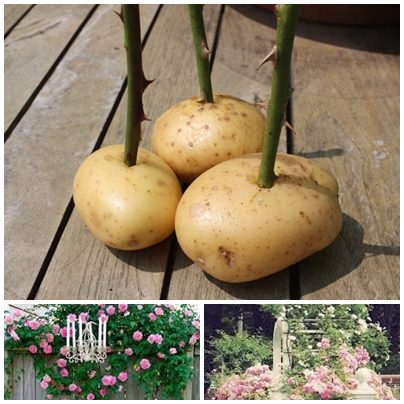

It is necessary to create greenhouse conditions for the cuttings. To do this, use plastic bottles with lids: cut off the bottom, and cover the shoots with the top. From time to time, the covers need to be removed so that the sprouts are ventilated.
In winter, cuttings are planted in pots with large holes in the bottom, then covered with a glass jar or plastic bottle. Drainage is laid at the bottom of each pot and covered with special soil for roses (all this is bought in a flower shop).
A month after planting, roots should appear. The sprouts planted in this way should be watered regularly, sugar should be added to the water every five days at the rate of 2 teaspoons per glass of water.After two weeks, young plants begin to "educate", gradually accustoming them to the conditions of open ground. To do this, open the protective casing, gradually increasing the airing time, and after two weeks remove it completely.
At the beginning of September, it is time to plant ready-made seedlings in the pits prepared for this. This is done so that in winter the roses can withstand the cold well. Fresh shoots appear on young bushes and a bud can be tied, which must be plucked so that the immature plant gives roots, and does not waste energy on flowering.
In plants obtained by vegetative propagation, the root system is less developed than in grafted ones, therefore they must be protected from hypothermia by covering them with spruce branches for the winter.
Planting a rooted cuttings in a flower bed
Growing roses in potatoes can be carried out at any time of the year, but it is better to plant seedlings in a flowerbed or in a front garden in spring or in the first half of summer: in a few warm months, the root system of plants will develop and grow stronger, and the roses will be ready for wintering in the open air.
Saplings must be planted in an area protected from drafts and sudden gusts of wind. Lighting also plays an important role - the more sun the bushes receive during the day, the more chances of their survival. To plant several specimens, you can dig a ditch 25-30 cm wide and 18-20 cm deep. It is more convenient to plant single seedlings in separate holes of the same size.
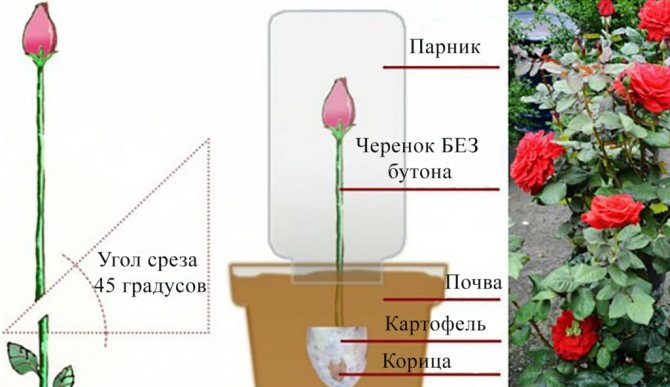

It is best to cover roses with jars or plastic bottles, this will create a greenhouse effect and the plant will take root faster.
Further care for cuttings planted in a flower bed is no different from the traditional cultivation of seedlings: they need to be watered as needed, fed regularly with a complex mineral fertilizer, and treated with insecticidal and fungicidal preparations in order to prevent diseases and pests.
If potatoes begin to sprout in a pot or in a flowerbed along with roses, its young shoots must be broken off. This technique will not allow the root crop to develop a root system and interfere with young seedlings.
To save the bushes until next season, you need to take care of their insulation in the fall. For several years, plants should be covered with sawdust, dry foliage of fruit trees or spruce branches for the winter. Plastic wrap or other airtight material should not be used, as the plant underneath will rot and die.
If roses were presented on the eve of winter, cuttings of the variety you like can be saved by digging in the garden and making a dry shelter above them. Until spring, they will not release roots, but they will not freeze either. In the spring, you can try to germinate them in potatoes, water, or in fertile soil.
Ways to grow roses from cuttings
The presented bouquets of roses are very beautiful, but, unfortunately, they quickly fade. And so I want to admire their beauty and grace for a longer time. It is possible. Do not rush to throw away the bouquet, try to sprout twigs. Of course, for breeding it is better to take fresh cuttings from rose bushes. Bouquets are often treated with chemicals, preservatives, which reduce the degree of rooting.
The chance of rooting imported roses is not great. Such flowers have come a long way, have lost their vitality. Red and pink varieties are most suitable, varieties with white, yellow and orange flowers take root worse. The best option for growing by cuttings is to use domestic roses that have already been acclimatized. To increase the chance of rooting, cut the shoots before or immediately after flowering. Roses are germinated in several ways:
- in water;
- wrapped in a wet cloth;
- in the newspaper;
- in the ground;
- in potatoes.


Propagation by cuttings is the most common method, since it gives one hundred percent guarantee of obtaining just such a plant as the mother material.Very often, cuttings are grafted onto rose hips, but in this case there can be no guarantee that the plant will show the properties of roses, and not rose hips. The method of growing roses in potatoes is rarely used, but in vain. This is the most effective method. The potato not only provides the seedling with moisture, but also the necessary substances for growth. It contains:
16 excellent varieties of plums for the Moscow region
- starch;
- proteins;
- mineral salts.
All this is necessary for the shoot to grow and form roots. Without a root system, these substances have nowhere to take the cuttings, and the potato supplies it with everything it needs.
Useful video
Watch a video on how to grow a rose from cuttings in potatoes:
If you find an error, please select a piece of text and press Ctrl + Enter.
Planting roses on a personal plot is the dream of, if not all, then very many gardeners. But seed material is usually expensive, and there is no guarantee that a rose of the same variety will grow from a nondescript seedling, the name of which flaunts on the label. Breeding roses with cuttings in potatoes makes it possible to grow a bush even from a presented bouquet.
In a store or on the market, grafted plants are sold, it also happens that the miracle of selection does not live up to expectations, the graft does not take root. And instead of a purebred beauty, an ordinary rosehip grows, on which the vaccine was made.
If reproduction is carried out in a vegetative way, then there will be no surprises, an exact copy of the plant that served as a "donor" of the planting material will grow from the cuttings. Such bushes are called own-rooted.
For the cultivation of roses by cuttings, it is advisable to choose domestic zoned varieties. Material from roses with white and greenish flowers is not suitable for vegetative propagation. The percentage of rooted cuttings from bushes with orange and yellow flowers is also low. Roses of red and pink varieties take root very well.
Climbing and semi-climbing, dwarf, polyanthus and bush roses are excellent for cultivation by cuttings, this is due to their genetic proximity to their ancestor - wild rose hips, which has excellent survival rate.
Imported roses are unfortunately not the best option. Before sending flowers on the road, growers treat the plants with chemicals and preservatives. Of the total number of planted stems, only 10-15% take root. But it makes sense to at least try! Procurement of planting material
Step-by-step instructions for growing roses in potatoes
- Healthy shoots are chosen for rooting. Cut off a stalk 20-25 cm long with four buds. It is better to cut the shoot under running water with a sharp knife. Leave a couple of leaves at the top, remove the rest. For rooting, shoots with formed buds are chosen, which are located in the leaf axils.
Attention! It is necessary to make the cuts correctly. The upper cut is made at a height of 1.5 cm above the upper kidney at an angle of 90 °. The lower one is done immediately under the kidney at an angle of 45 °.
- The lower part of the cutting can be greased with honey, dipped in aloe juice, put in a solution for several hours to stimulate the growth of the root system: "Kornevin", "Epin", "Heteroauxin". Planting material and potatoes can be treated with potassium permanganate solution.
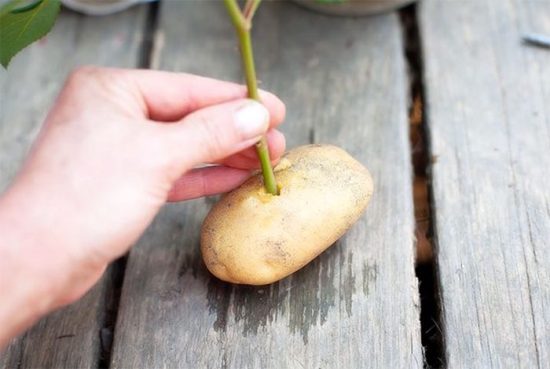

- Choose a medium healthy potato, cut out the eyes (so that the potato does not start to grow). We make a hole in the potato in diameter equal to the thickness of the cutting. Insert the shank with the lower part into the hole.
- The next step is soil preparation. For germination, choose small flowerpots or one large flowerpot for several roses. We fill the bottom with sand for drainage. Then we mix the soil with humus (1: 1). You can bake the soil in the oven to kill pests and harmful bacteria.
The video at the end of the article shows the step-by-step process of sprouting a rose in a potato.
Storing cuttings
If it was not possible to carry out cuttings of a rose in July - June, the prepared seedlings are stored until next year.Some do it in the refrigerator, for which the planting material is formed into bunches, dipped in a root former solution, then in a bag with wet moss and placed in a refrigerator, in a fruit box. Cuttings should be periodically inspected in winter, discarding those that have begun to rot. In the spring, a kind of outgrowth should appear on the oblique cut - callus, from which the roots subsequently develop.
The second storage method is in the ground. To do this, a shallow trench is dug, lined with grass or sand, and cuttings are placed there. From above, they are also covered with a layer of grass, spruce branches, straw, on top of which a protective film is laid and earth is poured. This method helps to keep the material in excellent condition until spring.


Cuttings care rules
We plant the potatoes with cuttings in the ground and cover with glass cylinders or plastic bottles. This is to prevent the cutting from drying out. Try to position the bottles so that the leaves do not touch the sides of the bottle. To prevent disease, you can water the soil with a weak solution of potassium permanganate. We put this structure in a warm, sunny place.
Watering should be done often and little by little. Excess moisture in the soil also leads to rotting of the cuttings. Water the soil with a sugar solution once a week (1 spoonful of sugar per 200 g of water). This will provide additional nutrients to the plant. Spraying can be used with watering.
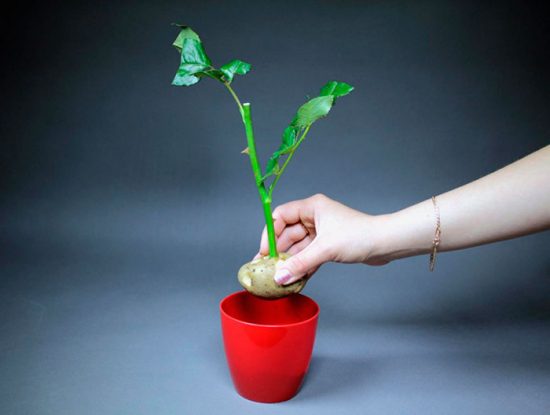

As a rule, the appearance of the first leaves coincides with the beginning of root formation. If you notice that young leaves are beginning to grow, accustom them to open air. At first for half an hour, and then gradually increasing the time, leave the plants open. Young plants can be opened after 2-3 weeks. After a few more days, you can transplant the rose to a permanent place. A rose can release a bud, it needs to be cut, no matter how much you want to admire the first flower. The plant is too weak to expend energy on flowering, which can lead to the death of the bush.
For full development, the seedling must be fertilized. Apply complex fertilizers for this purpose.
Flower bed design. TOP 10 simple and effective techniques
If the roses were intended for open ground, it all depends on the weather and the season. It is better to plant a seedling in open ground in the fall, so that the young plant does not dry out and adapts to the cold. With the onset of frost, the seedling must be insulated. Can be covered with pine branches or fabric insulation.
Attention! Do not cover roses with foil, it does not allow air to pass through.
Too early warming can lead to germination of shoots, and when cold weather sets in, they can die.
There are several ways to grow roses from cuttings at home. Whichever you choose, the most important thing is to follow the rules of planting and care: do not forget to water, feed and provide greenhouse conditions. The next year, a beautiful plant with graceful and fragrant flowers will grow from the cuttings.
Features of transplanting to a permanent place
Rose seedlings are transplanted to a place of permanent growth in the first half of autumn (until mid-October), so that they have time to take root before the onset of winter. It is advisable to prepare pits for bushes 2-3 weeks before transplanting. The size of the planting hole should correspond to the size of the plant's rhizome. If the soil is not fertile enough, then compost should be placed on the bottom of the pit, and then a layer of earth should be poured so that the roots do not come into contact with the fertilizer. Before planting, the pit is well moistened.
It is very important not to damage the roots when digging up a seedling. To do this, the plant needs to be watered well, and when the soil becomes wet, carefully dig in from all sides, and then remove the bush along with an earthen lump.
Next, the seedling is placed in a planting hole, the roots are straightened and covered with earth so that the root collar rises a couple of centimeters above the soil surface.The earth is tamped, the seedling is watered and mulched with a thin layer of humus. In autumn, plants can be fed with special mineral mixtures for roses without nitrogen content, since this element can cause a rapid vegetative process, which will significantly complicate the wintering of a rose.
Transplanting roses from a pot to the ground is carried out in the same way, with the only difference that the seedlings in pots 2 weeks before transplanting need to be hardened - taken out for several hours outside. For the winter, young plants are covered: the roots of organic mulch, and the bush itself with dense material. Pruning seedlings of the first year of life does not need to be carried out, their shoots are flexible enough, so the branches are simply bent to the ground and covered. In general, cutting roses using potato tubers is a simple, budgetary and quite effective way. Try it in practice and be sure that the result will please you!
How to properly grow roses from cuttings in potatoes?
Many gardeners prefer to grow roses in their personal plot, so sooner or later they try to multiply the variety they like. The best way is cuttings, as this makes it possible to grow seedlings while preserving all the specific properties of the mother bush. But it is not always possible to achieve the desired result, since when planted in the ground, cuttings often dry out from a lack of moisture, and when rooting roses in water, they die from a lack of oxygen.
The problem can be solved by rooting shoots in potato tubers, which will significantly increase the survival rate of young plants. This method helps to provide cuttings with the necessary moisture and nutrients at the initial stage of development and root formation. Moreover, for reproduction, you can use stems both directly cut from a bush in the garden, and from a bouquet of donated roses.
For reproduction, it is necessary to choose zoned crop species that are capable of growing and wintering in this climate. Cuttings of red and pink varieties can be rooted with minimal loss. Orange and yellow roses give a lower survival rate, white and greenish varieties are the worst suited for vegetative propagation - no more than 10-15%.
Polyanthus, curly, climbing, border and ground cover roses reproduce well from cuttings, which is explained by their genetic similarity with wild rose hips, which are distinguished by their high endurance.
In case of vegetative propagation, you should not take stems from imported flowers, since manufacturers, before sending them, carry out special processing for long-term storage. Therefore, cuttings from such material take root no more than 10%, but this does not mean that it is not worth trying and experimenting.
The main condition for growing roses from a bouquet is that it is necessary to take cuttings from fresh flowers, since after a long standing in water, the stems lose their vitality, and this reduces the survival rate to a minimum. Therefore, before placing the flowers in the water, it is necessary to make the lower oblique cut under the stream of water so that air cannot get into it. Then add one drop of honey to a vase of water and then change it daily. And immediately before grafting, cut off the bud.
The optimal period for harvesting rose cuttings from a bush is late May - early June. At the same time, it is not recommended to use stems with green buds or with faded flowers, since they have a low level of survival. Roses can be germinated from shoots at least 0.5 cm thick, and they should also have a green or slightly brown tint.


Prepared cuttings of roses
In the future, you should prepare the planting material for rooting, observing certain rules:
- one.Cuttings must be cut 15–20 cm long, but so that each of them has three vegetative buds.
- 2. Remove all leaves, leaving only the top pair on each section.
- 3. The bottom cut must be made at an acute angle of 45 degrees below the bud, but at the same time its length should be three times the thickness of the shoot. From above, the cutting should be shortened evenly, using a sharp pruner so as not to pinch the stem when cutting.
- 4. Put the planting material in water with “Heteroauxin” or “Kornevin” for 2 hours. In the absence of these drugs, you can use honey by adding it in a proportion of 15 ml per 1 glass of water or aloe juice, 20 drops per the same volume of water.
- 5. Burn both cuttings with potassium permanganate.
While the shoots are being prepared, it is necessary to select suitable potatoes. Large, well-ripened tubers without any external defects are better suited for vegetative propagation of roses. Before planting, it is important to remove all "eyes" on the potatoes in order to prevent them from developing in the future. In the center of the tuber, a deepening of 2–2.5 cm should be made along the diameter of the rose shoots. Then place one prepared cuttings in each tuber. Then carry out planting in the soil.
The method of growing roses in potatoes helps to protect the sprouts from drying out, which increases the percentage of survival of young plants in the future.
Preparing the cuttings and potatoes
In the eternal search for the best and most effective ways of rooting rose cuttings, many materials have been tried, among which the potato tuber turned out to be the most successful. Fresh potatoes contain a wide range of nutrients, especially starch. It is a long-term source of constant moisture and reliable protection against hypothermia, decay, and the development of bacterial diseases that sometimes affect roses at the initial stage of growth. In addition, it is technically easy to grow a rose stalk in fresh potatoes.
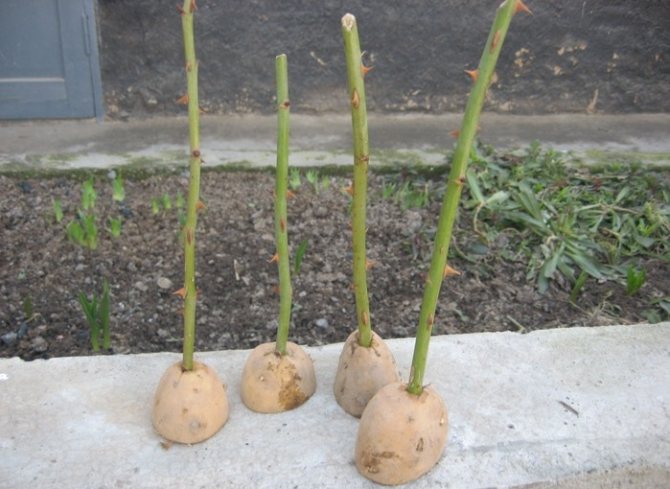

Before planting a rose in a potato, you should first prepare the tubers and the cuttings themselves. It is better to take young, recently dug tubers as a container for planting roses - they contain the maximum amount of nutrients.
If the stalk is grown in a pot in winter, then the freshness of the tubers is not so important, the main thing is that they are large, dense (not wilted) and without damage. All eyes on the tuber must be removed to prevent germination.
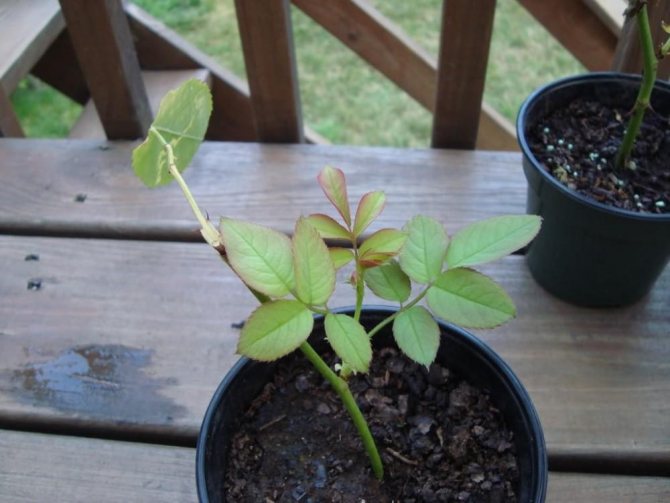

Cuttings (part of the green shoot) should preferably be cut at the end of May, when the rose blooms. For cutting cuttings, it is not recommended to use shoots with unripe buds, as well as with already faded roses, since it is very difficult to root such cuttings - they simply do not take root. Reproduction by cuttings is also possible from a purchased rose (from a bouquet) - there is no fundamental difference. However, it is important that the flower is not grown abroad, since imported roses are treated with a preservative that ensures long shelf life.
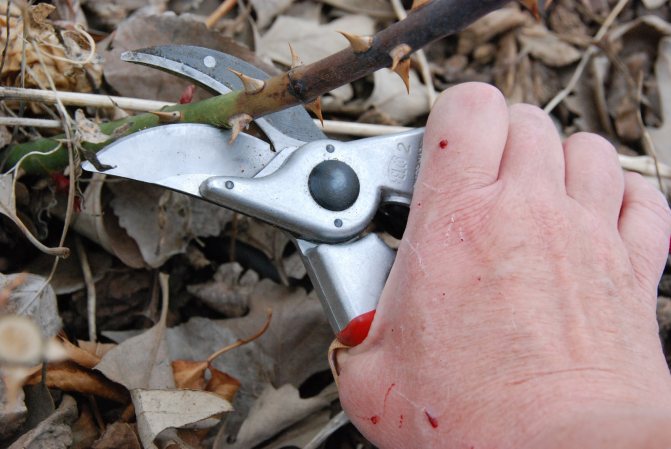

The length of the cutting should be 15-20 cm. Thus, 3-4 blanks can be obtained from one rose or one shoot of medium length. Cut the cuttings with a sharp object, preferably with a garden shears, so that the stem does not squeeze when cut. The lower cut is made 2 cm below the kidney at an angle of 45 °, the upper one is 1 cm above the kidney, and the cut itself can be either at an angle or straight. All leaves in the lower part of the cutting must be removed, leaving only a couple of upper leaves.


Further, the cuttings are treated with a weak solution of potassium permanganate for 12 hours, and then placed in a stimulating solution (Kornevin, Heteroauxin) for a day. You can replace these products with fresh aloe juice. After that, the cuttings are stuck in the lower part of the potato. In order not to break the stalk, you can make a hole in the potato with a long sharp object (screwdriver, large nail) and simply insert the workpiece.It should be clarified that the propagation of a rose in a potato is acceptable only for varieties with erect stems. To grow a climbing rose, not a cutting is used, but a layering - a buried shoot rooted in the soil, because growing a layering in a potato tuber is very difficult.
A reliable way to root a rose in a potato tuber
Adding an article to a new collection
The potato tuber is an ideal "container" for plant rooting, because it contains a lot of nutrients. In addition, it will protect young roots from decay and hypothermia.
If you were presented with a luxurious rose, do not be sad about the fact that it will wither, and the beauty will disappear without a trace. Go urgently to the store (or cellar) for a few potato tubers, and then the flower will have a chance for a second life, because this is a great way to root it!
Potatoes - a ready-made vitamin bomb for roses
Reproduction of climbing roses
Cutting of a climbing rose in the summer is carried out using the usual methods (then the stems for planting material are cut from the bush early in the morning) or with the help of layering. To do this, a shallow groove is pulled out next to the bush, filled with prepared soil for roses, a suitable one-year-old stem selected for brood is cut under the kidney, bent to the groove and secured with a wire pin.
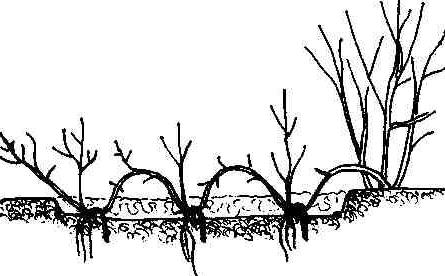

From above, this place is covered with earth so that 20-30 cm of the stem remains on the surface, sticking up vertically, but you do not need to make a very large hill. Periodically during the summer, the layers are watered, covered for the winter. In the spring, if the rose is accepted, it can be cut off from the original bush and planted in the desired place.
The perfect pot for roses
Does it make sense to once again remind you of the beneficial properties of potatoes? This representative of the nightshade family has an irreplaceable set of nutrients and moisture not only for humans, but also for roses. If you stick a freshly cut rose stalk into a potato, it will almost certainly take root.
Potatoes of the varieties Izora, Anosta, Red Scarlett, Aerrow are best suited for growing roses.
So, a very simple way to root a rose in a potato tuber:
- choose a place on the site where you will plant roses. It must be well lit and protected from wind and drafts;
- dig a trench about 50 cm deep and pour a layer of sand on the bottom so that the tubers, and with them the roses, do not rot due to excess moisture;
- wait for a gift in the form of a bouquet of fresh roses, buy a few pieces yourself, or cut off young shoots from growing garden roses (cut at an angle of 45 degrees). Use pencil-thin cuttings that are healthy, strong and straight. Foreign roses, perhaps, are not the best option - they can be saturated with a preservative, because their freshness was maintained artificially;
- cut cuttings 20-25 cm long, remove leaves and thorns from them;
- take new potatoes, just do not forget to remove the eyes from it. Make a hole in the tuber with a screwdriver or nail, insert one cutting into each potato;
Before starting work, disinfect the nail (screwdriver) with alcohol, Virkon, or simply ignite it on fire
- bury the potatoes at a distance of 15 cm from each other - this way you protect them from microbes living in the soil and provide moisture for a long period;
After a couple of weeks, check if the rose has taken root by gently pulling on the tip of the stem
- Backfill the trench with about 2/3 of the earth and tamp it well.
The most important thing for a young plant is timely watering, and potato tuber will help it accumulate moisture. In a humid environment, the pink stem will quickly take root, and by the end of summer, the grown seedling can be transplanted to a permanent place.
Landing
Cuttings are inserted into the sand to a depth of no more than 2 cm, set at an angle, and watered. Some gardeners recommend pouring sand up to 10 cm, and insert the cutting to its full thickness.These mini-beds should be moist all the time, but without excess water. The cuttings themselves and the remaining leaves should be regularly sprayed with water from a spray bottle. To make it easier to comply with the humidity regime, they resort to such a procedure as cutting roses in the summer under a jar. One and a half liters are best suited. But even after covering the cutting, you need to monitor the humidity of the air. The container should not be exposed to direct sunlight at all. Otherwise, the stalk will simply burn out there. An alternative to a bank (especially convenient when many cuttings are rooted at once) is to build a kind of greenhouse over the mini-bed. This is done using a frame and plastic wrap. Cuttings are planted at least 5-7 cm from one another. If there is little planting material, it is convenient to replace the cans with plastic bottles. About 1/3 is cut off from them from the bottom. The remaining part (with a lid) is covered with the handle, inserting plastic into the ground so that there are no cracks. The lid is convenient to use for airing the seedlings. If everything was done correctly, the first roots will appear in 14-20 days. They will develop into full-fledged roots in a couple of weeks.
Cutting bouquet roses in autumn
Autumn is a good time to sprout a rose stalk. This method has several advantages:
- Such an adult bush will not have rose hips.
- Roses on their own roots tolerate severe winters well.
- The shoot can be easily obtained from a donated bouquet or ask your neighbors in the country.
The term for cuttings coincides with the pruning of the shoots for the winter. Therefore, grafting takes place at the end of October. The cuttings are prepared in the usual way and proceed to planting. They are immediately planted in a permanent place and this is a huge plus in the propagation of a rose. The shoots treated with a growth stimulant are lowered into the ground at an angle of 45 degrees and spilled abundantly with water. After planting, 1-2 growing buds remain above the ground. All cuttings are covered with glass or plastic containers and removed in spring with the onset of steady heat.


Photo
So, we examined step by step this method to grow a rose, and then in the photo you can see how the cuttings of a flower that were planted in potatoes look like.
Features of the method
This method of growing a cutting has its own characteristics. It has proven itself well as a way to get a rose sapling from a donated bouquet. Of course, it is not suitable for imported varieties, as they undergo long-term transportation and chemical processing. But for growing domestic roses that have already passed acclimatization, it is quite suitable.
The use of potato tuber allows the plant to receive a sufficient amount of moisture, as well as micronutrients and macronutrients.
Other ways to propagate roses by cuttings
Propagation of roses by cuttings in a package
The lower part of cuttings cut in the usual way is placed in a bag with sterile soil or moist sphagnum moss moistened with aloe juice in a ratio of 1 (juice) to 9 (water). The bag is inflated, tied tightly and hung on the window. A fog appears in the bag from high humidity, and after a month the first roots appear on the cuttings. Plant the cuttings as described above.
How to plant and care for roses in the garden
Planting rose cuttings before winter
The meaning of this method is to keep the cuttings alive until spring, capable of vegetation and rooting. The fact is that before winter this method will not force your cuttings to release roots, and it may not be very convenient to keep them in the house for the winter, therefore, flower growers have come up with such a method as replanting cuttings before winter. In addition, there are times that it is in the fall that you get a unique rose, and it will be a shame to miss the opportunity to breed a bush or two of rarities. Therefore, simply dig the cutting into the ground and make a dry shelter on top so that it does not die from the cold in winter, and in the spring, transplant it to a permanent place in the usual way.


Burito's way
Until the end, it did not become clear why this method is so good, because it does not give not only one hundred percent rooting, but even about fifty percent is not necessary to speak. Although if you are gambling, then why not give it a try? Cuttings are cut from the stems, the lower end is treated with root, epin or some other means to stimulate root formation, then the cuttings are wrapped in wet newspaper and placed in a dark place for two weeks at a temperature of 15-18 ºС. And, supposedly, roots should appear.
Climbing roses - planting and care in the garden
How to plant a rose from a bouquet at home?
Many will be surprised, they say, why make so much effort if you can just buy ready-made cuttings in gardening stores and just plant them in the ground.
To begin with, there is no guarantee that the store rose will take root on the site.
The bushes on sale are grown in special conditions, where a special composition of the soil is selected for them, stimulants and various dressings are used, having lost which the plant begins to hurt and dies.
Of course, this is not always the case, but nevertheless there is more confidence in self-grown.
The second “pros” is the desire to have on the site exactly the rose that was presented as a gift in a bouquet.
And the price, of course, matters. Self-cultivation is many times more economical.
Some are afraid to take on this business, believing that they will not cope with the difficulties, that it is necessary to have some experience to grow roses.
However, even a beginner is able to master the task, especially since further we will consider in detail the most effective ways to grow roses from a bouquet.
Role of potato tubers
The most favorable period for harvesting cuttings is the end of spring. It is during this period that the rose blooms, because you cannot cut off unripe buds. You can use thorns to distinguish an immature bud from one suitable for breeding. In a ripe flower, they will break off without much effort. On a green stem, the thorns are still young, and when they try to break, they will just bend.
If you cut cuttings from a flower with a stem of medium length, in this case, several future seedlings can be obtained from one branch at once. Ideally, the size of a suitable cutting should be about 15 centimeters. At least 3 buds should be left on each of them. The lower cut should be done 2-3 centimeters below the kidney. The cut angle must be sharp (45 degrees). It is very important to cut the stems with sharp scissors or garden pruners so that the cut is smooth and of good quality, without squeezing the stem. ...
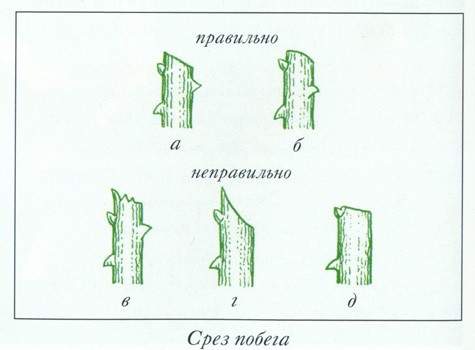

The upper cut must be made at a distance of 1 centimeter above the kidney, it must be even. All foliage that is located at the bottom of the cutting must be removed, leaving only a few upper leaves. After that, it is recommended to treat the cut sites with a manganese solution, and place the cuttings in aloe juice for 10-12 hours.
The next stage of the cuttings is the preparation of the potatoes. There are no requirements for the size of potatoes used for breeding roses, but ideally, it is advised to use medium-sized tubers (without signs of damage and disease). All eyes should be removed from the potato skin.
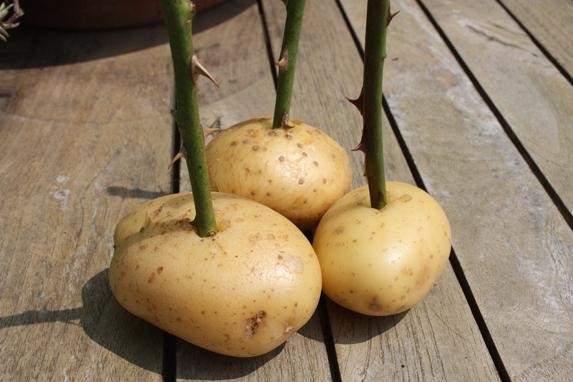

All cuttings that will be used for growing a rose must be placed in a heteroauxin solution for a day, after which each of them is stuck with the lower sharp part into a separate potato. The next step is to plant tubers with cuttings in small pots, followed by watering with a slightly boring solution of potassium permanganate.
The use of potatoes for growing a rose is a fairly simple and cheap method, which guarantees a high chance of successful rooting.
Planting cuttings in potatoes


Stick the prepared stalk into the potato tuber with a sharp cut. It should be free of damage and without eyes. One stalk is stuck into one potato.Plant a potato with a shank in a pot with nutritious soil, lay a drainage layer of expanded clay on the bottom of the flowerpot, and cover it with a glass jar on top. You can also use a plastic bottle.
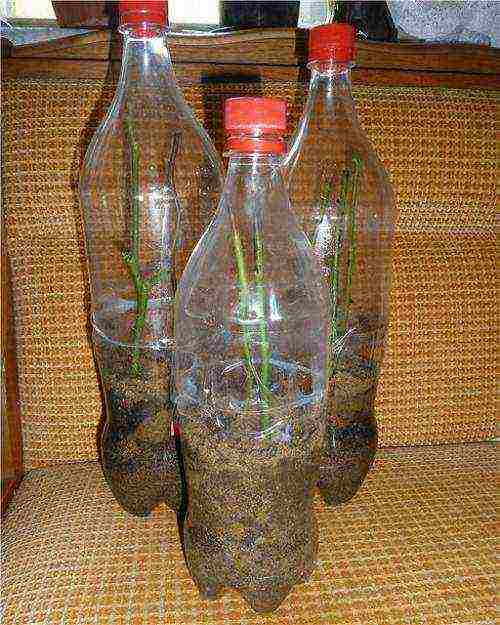

The leaves remaining on the handle should not come into contact with the walls of the jar.
Is it possible to root flowers from a bouquet in winter
There is no definite answer. It all depends on which rose the stem is taken from. With a Dutch rose in winter, the root system on the shoot cannot be obtained unambiguously. You can try to cut a local rose, but the process will be quite lengthy and even when the sprouts grow from the sinuses, the shelter should not be removed, since the roots are formed very slowly, and the sprouts can grow at the expense of the main stem. The best choice is to plant the stalk in a clear plastic cup in winter so that you can monitor the formation of roots. But the rooting process will be long, if in the summer in a month you can get small roots on the shoot, then in winter the cutting can stand all winter and only with the onset of spring will it begin to build up the root system.
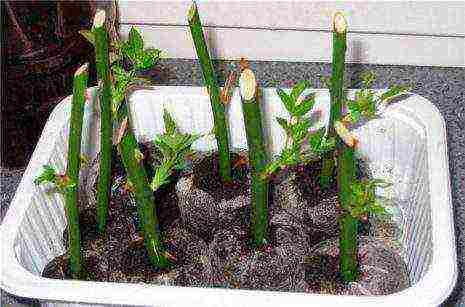

Planting a cuttings in a tuber
How to plant a rose in a potato? The procedure is as follows. After preparing the potatoes, a puncture is made in its lateral part with a disinfected instrument. To do this, you can use a knife, screwdriver, or other stabbing object.


The depth of the hole should be five centimeters, and the width should be slightly larger than the diameter of the cutting. Otherwise, the planting material may be damaged. When choosing a potato variety, you should focus on the moisture content in it. These qualities correspond to such varieties as "golden yukon", red and white potatoes.
How to grow roses in potatoes? First you need to immerse the cutting in a root growth agent. The excess amount of powder is shaken off, and the cutting is inserted into the hole made in the tuber. The potatoes are placed in the soil so deep that the top is completely covered with soil. The shoot of the rose in the potato should remain open, not covered with earth. If the planting was carried out before winter, the tuber will take root well during the cold period, the cutting will take root, and it can be transplanted into another container in the spring, or it can be left in a pot.
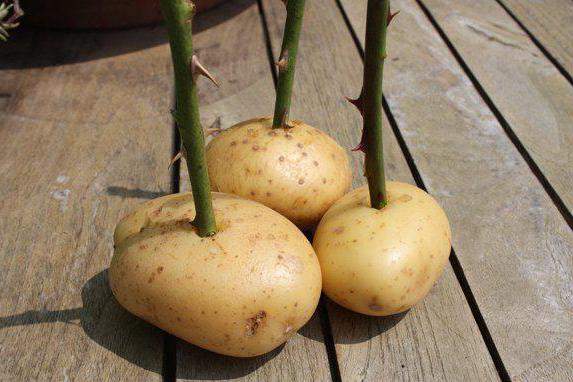

A peg is driven in close to the rose. The plant is weakly tied to it with a thin twine, preferably from a cotton thread. This will serve as a support for the still unrooted plant.
The soil in the pot should be moist and crumbly. But this does not mean that watering is carried out frequently. On the contrary, excessive moisture can lead to rotting of the tuber. In this case, the rose will die.
In order not to be tormented by doubts whether the rose has begun or not, after about fourteen days, you need to gently pull the tip of the plant. If the stalk can be easily removed, this means that it has not yet begun. It needs to be pushed back into the hole in its place. A week later, a similar check is carried out in order to find out how the rose feels in the potato. The method of cultivation, if desired, you can choose another or stop there, only for rapid growth, you should feed the bush with a universal fertilizer.
Preparing potatoes
How to grow roses in potatoes? In this vegetable, you can easily grow garden and home flowers of this species. But first you need to carry out the preparatory work. It is better to choose large tubers. If these are not available, medium-sized specimens will do.
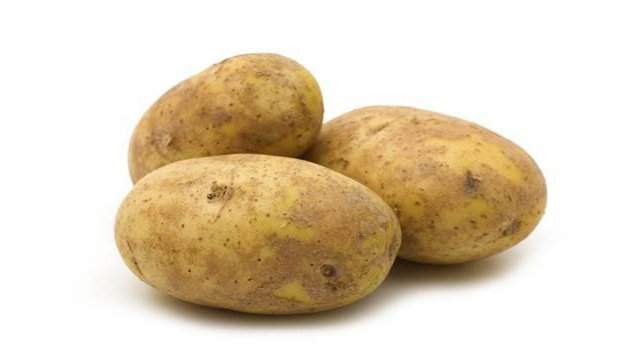

A thorough examination should be carried out to determine if there is any damage as a result of mechanical stress or illness. Then you need to remove all the eyes in order to prevent germination of the tuber. Reproduction of a room rose in a potato environment, provided that the cutting is properly prepared, will go well.
Preparatory stage
To germinate cuttings of roses in potatoes at home, you need to prepare the tubers and the cuttings themselves.A rose from a bouquet will take root in the garden only if it did not have time to bloom. Otherwise, the probability of a positive outcome is rather small. Also, pay attention to the thickness of the stem of the rose - a flower that is too thin may not take root, so choose stems thicker than 0.5 mm.
Potatoes act as a nutrient substrate for the flower - it transfers the accumulated nutrients, saturates the flower with the necessary moisture.
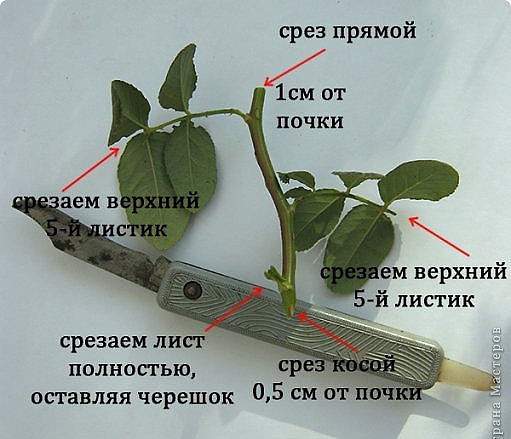

How to properly cut rose cuttings
Cutting preparation:
- Remove leaves, thorns from the stem;
- Cut off the top with a sharp secateurs or scissors. Make sure not to pinch the stem while pruning. The lower cut should be carried out at an angle of 45º, and the upper cut strictly straight;
- Divide the stalk into several parts - several bushes can be grown from one flower, the main thing when dividing is to leave at least 3 buds on each part of the stalk;
- Place roses in a biostimulant. If there is no specialized tool, then you can make it yourself from aloe, or honey (a tablespoon of honey in a glass of water). Or set the flowers in a solution of potassium permanganate. The cuttings should be kept in the nutrient solution for at least 2 hours;
- Burn the cuttings with a solution of potassium permanganate.
This completes the preparation of the cuttings, and you can proceed to the potatoes. Potato tubers should be large in size, without signs of disease or cuts. It is important to remove all the eyes from the tubers, otherwise the potato will sprout and may "strangle" the flower. Next, stick the cuttings into the potatoes, piercing each tuber to about the middle. The workpieces are ready for planting in the ground. Now the nutrients from the potato will saturate the rose and the flower will grow faster.
Soil preparation
It is best to use universal purchased soil for planting a home rose. For those who are used to doing everything with their own hands and saving money, you can cook it yourself. How to plant a rose in a potato? First you need to prepare the soil. Two parts of garden soil and the same amount of humus are mixed. One part of the sand is added to this mixture. Everything mixes well and is placed in the oven. This is done in order to destroy possible pathogenic bacteria, which will die under the influence of high temperature.
Rooting methods for cuttings
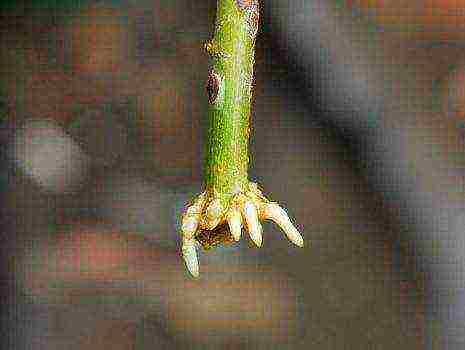

Rooting of cuttings depends on the variety of roses. If local varieties of roses are involved in the bouquet, then the shoots will give roots quickly and without problems. If a grower is going to grow roots on Dutch roses, then you can get a positive result on only 40% of the cuttings. This, it turns out, is due to the fact that roses are processed with certain hormones that slow down the process of wilting, but they also inhibit the formation of the root mass on the shoot.
IMPORTANT! It must also be remembered that in spring the process of root mass formation is more active than at other times of the year. The root growth stimulator "Kornevin" will help to grow roots.
Germination in water
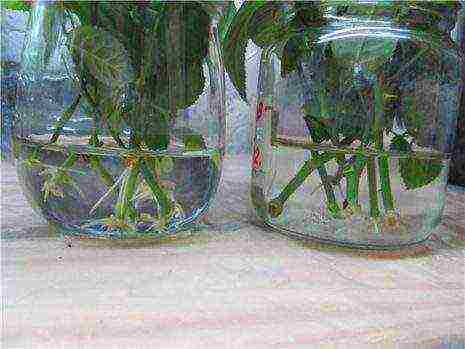

Germinating cuttings of roses in water is the easiest option. To do this, they are immersed in water by 1/3. Water must be used filtered and separated during the day. The vessel is placed in that place:
- where there are no drafts;
- no rays of direct summer sun;
- no sudden changes in temperature.
It should be remembered that the water is changed every other day. After about a month, white tubercles will appear at the ends of the cuttings - these are future roots. When the roots become 5 cm long, the shoots are planted in nutritious and loose soil.
Using potatoes
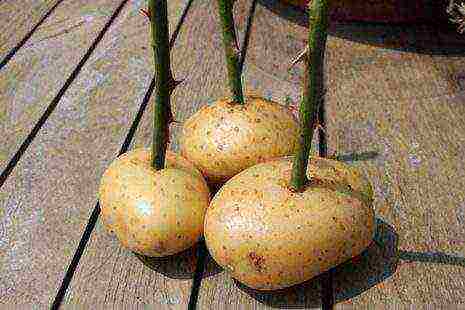

If you choose this method, then the potatoes will serve as a breeding ground for the formation of roots. The potato tuber must be:
- healthy;
- no mechanical damage;
- strong and resilient.
To prepare the selected potatoes, it is necessary to remove all the eyes from it, rinse under running water and make holes with an awl, where the cutting will actually be inserted.
You may be interested in:
IMPORTANT! Making holes do not make it through into the stalk, before sticking it into the potato, envelop it with growth stimulant powder.
In this way, you can grow shoots in an apartment, or you can immediately in the open field. To do this, a shallow trench is dug, no deeper than 15 cm, a 5 cm layer of sand is poured and potato tubers with rose cuttings stuck into it are already placed on it. When burying the processes, the apical bud should be left on the surface.
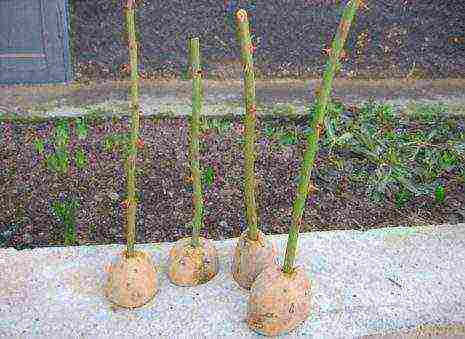

After planting, everything is well spilled with warm, settled water and covered with a cut plastic bottle to create a greenhouse microclimate. For the winter, such a shelter is not removed, but buried slightly with earth and then buried in snow. In the spring, a small bush will already be in place of the cutting. But such reproduction is suitable for the middle and southern regions of Russia; at the latitude of the Moscow region, young shoots must be additionally covered with spruce branches and lutrasil.
Using the package
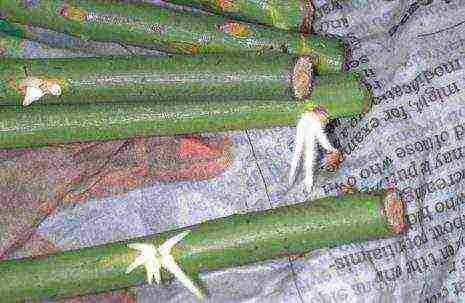

Today it is an unusual way to germinate the root system on a rose cut. All shoots are carefully wrapped in wet newspaper in such a way that cuttings do not peep out from under it. This wet bundle is placed in a black bag and put into a room where the air temperature will not rise above +20 degrees Celsius.


IMPORTANT! When propagating a rose in this way, it is necessary to check the condition of the cuttings once a week and get rid of the spoiled ones.
Rooting in a pot
This method is the most traditional. For this purpose you will need:
- Small capacity.
- Nutritious and loose soil.
- A glass jar large enough to cover a planted rose stalk.
- Shoots of roses.
The pot and expanded clay are poured over with boiling water to get rid of various fungal infections that may be there. The soil must be steamed in the oven for 20 minutes at 200 degrees - this is done to disinfect it from pests.
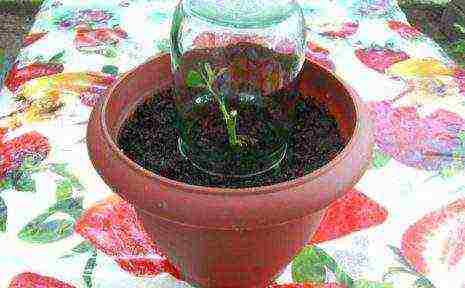

A 2 cm layer of expanded clay is placed in the prepared pot, the calcined soil is poured and well moistened. Now proceed directly to planting the prepared cutting. It is lowered with an oblique cut into the ground, deepening, so that the lower growth bud is immersed in the ground. The shoot is covered with a jar in order to form a humid greenhouse climate, this will give more guarantees for the viability of the cuttings.
If several cuttings of the same variety are planted in one container, then they are lowered into the ground with a step of 7 cm.
In the future, it is necessary to ensure that the soil under the jar or package does not dry out, but is moderately moist all the time. The temperature in the room where the cuttings will germinate should be in the range of 18-25 degrees Celsius. When small branches begin to grow from the internodes, there is no need to rush and immediately remove the jar. It is necessary to gradually accustom the young growth to the environment and the jar is raised by 2 cm so that air can enter under it. This will protect the cutting from black leg disease.
Advantages and disadvantages of the method
Like any other rooting method, growing a rose from a cut in a potato has positive and negative points.
The advantages of the method include:
- simplicity of the technological process;
- the ability to root even a flower from a presented bouquet;
- the rose receives an excellent level of moisture, oxygen and nutrients from potatoes;
- the tuber will protect the plant from negative factors.
The use of potatoes prevents spoilage of the future seedling. For example, when directly planted in the ground, it can dry out, and when germinated in water, it can rot.
The disadvantages of this method include:
- the method cannot be used for all types of roses, it is not suitable for propagation of weaving varieties;
- only plants with a straight stem can be used;
- after transplanting to a permanent place, 15% of the plants die, despite the developed root system;
- high demands are placed on the landing site (no drafts and direct sunlight, nutritious soil)
Other ways to cut roses
Cuttings in a package
Prepared cuttings of roses must be placed in a bag, into which a sterilized substrate or sphagnum moistened with a solution of aloe juice (1 part of juice and 9 parts of water) is previously poured. Then the bag should be inflated and tied well. It must be hung on the window. Due to the high humidity, a kind of fog forms inside the bag, and after about 4 weeks the first roots appear on the cuttings. Then they need to be landed, as described above.
Planting cuttings before winter
This method is used to preserve cuttings until the onset of spring. With the onset of warmth, they can give roots and begin to grow. The idea is that the cuttings will not take root until spring comes and will remain alive. The fact is that it is not always convenient to store the stalk in room conditions throughout the winter. And sometimes it is in the autumn that truly unique varieties of roses come across. To do this, you need to dig the stalk into the soil. And in order to protect from winter frosts, a dry shelter must be placed on top. In the springtime, transplant the cuttings to their usual place.
Burito's way
This method is quite ineffective, but it is still quite popular among flower growers. The lower part of the prepared cuttings must be treated with an agent that stimulates the formation of roots (epin or root). After that, the cuttings should be wrapped in damp newsprint and placed in a dark, cool (from 15 to 18 degrees) place for half a month. And after this period has expired, roots should form on the cuttings.
Trannois way
The meaning of this method is that, before cutting the shoots into cuttings, they can absorb the maximum amount of starch from the leaves. As a result, they will become more resilient and stronger. Experts advise that after the main flowering wave is completed (usually in June or July), it is necessary to select suitable shoots and cut off the upper part from them with a fading flower and 2 small leaf plates. After the buds swell in the lower part of these shoots, it is necessary to cut them into cuttings. This must be done in a fairly short time, without waiting for young leaves to appear from the buds. Cuttings should be cut as described above. Their length should be equal to 20 centimeters, and they need to cut off all the leaves, leaving only the top 2. These cuttings should be immediately planted in open ground at an angle of 45 degrees. In this case, it is recommended to plant several cuttings in one hole. As a shelter, plastic bottles with a volume of 5 liters are used, from which the upper narrow part should be cut off. They are not removed until the onset of the winter period, even if leaves and young shoots begin to grow. Cuttings should be provided with systematic watering, as well as loosening the soil.
Preparing cuttings for planting
First, the rose is soaked in water to the level of the flower calyx overnight. Only after that you should start preparing the cutting for planting. The diameter of the stem should not be less than half a centimeter. An initial cut of the stem is made. This is necessary to cleanse it.
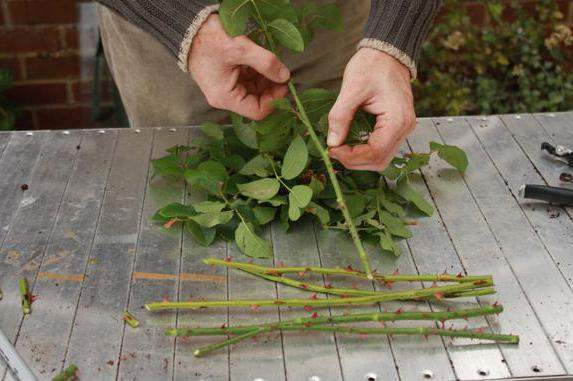

Then the stem is trimmed again by fifteen centimeters, but not below two or three buds. They should stay on the stem. If there is not enough planting material, only one bud can be left on the cuttings and its length can be reduced to about six centimeters. Then the plant is placed in a container with a stimulating solution for a period of twenty-four hours. The solution can be prepared independently from fresh aloe juice and water in a ratio of one to nine. You can use honey water: for half a liter of water - a teaspoon of honey.




